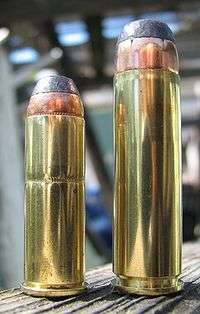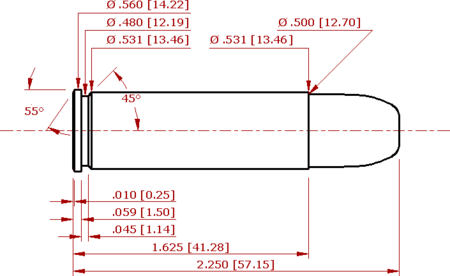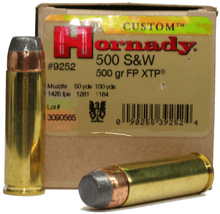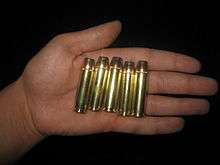.500 S&W Magnum
The .500 S&W Magnum (12.7×41mmSR) is a fifty-caliber semi-rimmed handgun cartridge developed by Cor-Bon in partnership with the Smith & Wesson "X-Gun" engineering team for use in the Smith & Wesson Model 500 X-frame revolver and introduced in February 2003 at the SHOT show.[5] It has two primary design purposes: as a hunting handgun cartridge capable of taking all North American game species, and to be the most powerful production handgun cartridge to date.
| .500 S&W Magnum | ||||||||||||||||||||||||
|---|---|---|---|---|---|---|---|---|---|---|---|---|---|---|---|---|---|---|---|---|---|---|---|---|
 Comparison of the popular .44 Magnum (left) to the .500 S&W cartridge (right) | ||||||||||||||||||||||||
| Type | Centerfire (.50 caliber) | |||||||||||||||||||||||
| Place of origin | United States | |||||||||||||||||||||||
| Production history | ||||||||||||||||||||||||
| Designer | Cor-Bon, Smith & Wesson | |||||||||||||||||||||||
| Designed | 2003 | |||||||||||||||||||||||
| Manufacturer | Smith & Wesson | |||||||||||||||||||||||
| Produced | 2003–present | |||||||||||||||||||||||
| Specifications | ||||||||||||||||||||||||
| Bullet diameter | .500 in (12.7 mm) | |||||||||||||||||||||||
| Neck diameter | .526 in (13.4 mm) | |||||||||||||||||||||||
| Base diameter | .526 in (13.4 mm) | |||||||||||||||||||||||
| Rim diameter | .556 in (14.1 mm) | |||||||||||||||||||||||
| Rim thickness | .056 in (1.4 mm) | |||||||||||||||||||||||
| Case length | 1.625 in (41.3 mm) | |||||||||||||||||||||||
| Overall length | 2.3 in (58 mm) | |||||||||||||||||||||||
| Rifling twist | 1:18.75 in (476.25 mm) | |||||||||||||||||||||||
| Primer type | Large pistol originally, now Large rifle | |||||||||||||||||||||||
| Maximum pressure | 60,000 psi (410 MPa) | |||||||||||||||||||||||
| Ballistic performance | ||||||||||||||||||||||||
| ||||||||||||||||||||||||
| Test barrel length: 8.375 in Source(s): Hornady (300 gr),[1] Winchester (400 gr),[2] Double Tap,[3] and Ballistic Supply,[4] | ||||||||||||||||||||||||
Cartridge history
Smith & Wesson had been at the forefront when developing powerful handgun cartridges such as the .357 S&W Magnum and the .44 Remington Magnum. However, since 1960 the company’s .44 Remington Magnum, which it had developed in partnership with Remington, was eclipsed by the .454 Casull. Since then, several other more powerful cartridges had been developed by Action Arms,[6] Linebaugh, Ruger, Wildey, and Winchester for repeating handguns.
In 1971 Smith & Wesson had experienced a dramatic surge in orders for their Model 29 revolver in the .44 Magnum cartridge with which S&W production was not able to keep up. Available Model 29 revolvers were being sold for two to three times the suggested retail price, because of the low supply and high demand for the revolver. This surge in demand was due to the 1971 film Dirty Harry, where the Model 29 revolver was billed as the most powerful revolver (The .454 Casull designed in 1955 was not in commercial production until 1997). With the entry of the .500 S&W Magnum and the Model 500 revolver, Smith & Wesson recaptured the title of the most powerful handgun,[7] and with it an increase in sales.
The .500 Smith & Wesson Magnum was designed from the outset to be the most powerful production handgun cartridge. S&W product manager, Herb Belin, proposed the idea of developing the revolver and cartridge to the S&W sales team. With the backing of the sales team, the project was approved by S&W President Bob Scott. The ammunition would be developed by Cor-Bon and Peter Pi in partnership with the S&W X-Gun engineering team of Brett Curry Lead Design Engineer, Rich Mikuta, and Tom Oakley. Eleven months later on January 9, 2003, the team unveiled the S&W Model 500 revolver and the .500 S&W Magnum cartridge. According to Belin, the cartridge was designed from its inception to be substantially more powerful than any other production handgun cartridge before it.[5] Cor-Bon would later go on to develop the .500 S&W Special cartridge.
Cartridge design and specifications
The .500 S&W Magnum is a semi-rimmed, straight cartridge optimized for use in revolvers. The cartridge is designed to headspace on its rim. However, unlike rimmed cartridges such as the .44 Magnum and other cartridges designed for use in revolvers, the cartridge can be cycled more smoothly and more reliably in tubular magazines, due to the semi-rimmed design. However, the cartridge does not cycle well through box magazines. The rim tends to lock in the extractor groove.
The .500 S&W Magnum was designed to fire a bullet with a diameter (⌀) of 0.500 in (12.7 mm) unlike the .500 Linebaugh, which fires a 0.510 in (12.9 mm) bullet. This was done so as not to run afoul of the National Firearms Act and be considered a Destructive Device as had happened to Whildin’s .50 AE cartridge, which at first was designed to fire a 0.510 in (12.9 mm) but had to be redesigned to fire a 0.500 in (12.7 mm) instead.

- SAAMI compliant .500 S&W Magnum cartridge schematic: All dimensions in inches [millimeters].[8]
The .500 S&W Magnum has a maximum working pressure of 60,000 psi (4,100 bar). However, most factory ammunition is limited to 50,000 psi (3,400 bar) to help ease extraction of fired cases. The cylinders of the S&W Model 500 revolver are engineered to be capable of withstanding 50% over pressure. Regular proof-load testing is performed at 20% over pressure.[5]
The cylinder bore diameter is given as .500 in (12.7 mm). SAAMI recommends a 6 groove barrel with each groove being 0.130 in (3.3 mm) wide. A barrel with a bore diameter of 0.4880 in (12.40 mm) and a groove diameter of 0.4983 in (12.66 mm) is also recommended. The recommended twist rate is 1 in 18.75 in (476 mm). While the bore diameter of 0.4880 in (12.40 mm) is consistent with other firearms which fire a 0.500 in (12.7 mm) diameter bullet, the groove diameter of 0.4983 in (12.66 mm) is an oddity as most firearms which fire a 0.500 in (12.7 mm) will have a groove diameter of equal to the diameter of the bullet.[8]
While the overall length is given as 2.300 in (58.4 mm) by many sources, some revolvers will not be able to accept cartridges with bullets seated to this overall length. This is because the cylinders of the revolvers are too short to accommodate such cartridges. The now-discontinued Taurus Raging Bull 500 is an example of one such revolver. It has a cylinder which is about 0.200 in (5.1 mm) shorter than that of the S&W Model 500.[9]
Performance

The .500 S&W Magnum is considered the most powerful commercial sporting handgun cartridge by virtue of the muzzle energy it can generate.[5] Cor-Bon (now a Dakota Ammo brand) who together with Smith & Wesson developed the .500 S&W Magnum cartridge, offers several loads which include a 325 gr (21.1 g) at 1,800 ft/s (550 m/s), a 400 gr (26 g) at 1,625 ft/s (495 m/s) and a 440 gr (29 g) at 1,625 ft/s (495 m/s). Compared to the next most powerful commercial sporting handgun cartridge, the .460 S&W Magnum, which can launch a 325 gr (21.1 g) at 1,650 ft/s (500 m/s) or a 395 gr (25.6 g) at 1,525 ft/s (465 m/s). The .500 S&W Magnum comes into its own when used with heavier bullets, particularly those with weights of 500 gr (32 g) or greater. When possible these bullets should be seated as far out as possible to take advantage of the complete cylinder length, so as to maximize the powder capacity which the case can provide.
Several manufacturers currently produce the S&W .500 Magnum cartridge, with some of the top-performing rounds delivering 3,031 ft⋅lbf (4,109 J) of energy with a 350-grain (23 g) bullet traveling at 1,975 feet per second (602 m/s). It is claimed to be the most potent commercially available handgun cartridge on the market and provides power similar to long-established wildcat cartridges such as the .375 JDJ (J. D. Jones) [10] and pistol loadings of the .45-70 Government. Indeed, some rounds use bullets weighing almost 1 oz. (28 g ~ 440 gr.), which are sent at about 1,500 ft/s (460 m/s) – essentially the same performance of a 12 gauge shotgun slug.[7]
Bullet weights available for this cartridge range from a 265-grain (17.2 g) jacketed hollow point to a 700-grain (45 g) hardcast lead bullet. Moderate velocity, heavy bullet loads for the .500 S&W Magnum are similar in performance to the black powder .50-70 Government. The heaviest weight bullet, produced by Underwood Ammo, is a hardcast lead bullet weighing 700 grains, about the same weight of a common .50 BMG projectile. This bullet, launched at a little over 1,200 ft/s (370 m/s) produces around 2,100 ft⋅lbf (2,800 J). While in terms of sheer muzzle energy, it is one of the softer rounds, this loading is actually the most preferred for hunting big game, as the bullet has excellent sectional densities, allowing for deep penetration and high expansion.

Low recoil or reduced recoil ammunition is manufactured by the Grizzly Cartridge Company and Winchester. The low recoiling ammunition reduces the recoil by lowering the velocity of the projectile and/or the mass of the projectile. Winchester's reduced recoil X500SW ammunition propels a 350 gr (23 g) bullet at 1,400 ft/s (430 m/s). Although such ammunition is considered low recoiling, due to having about one-third of the recoil energy of full-power .500 S&W ammunition, even these are a significant step up from most of the .44 Magnums, as they produce twice the recoil energy of the latter cartridge.
Cor-Bon introduced the .500 S&W Special in 2004 as a lower energy and lower recoiling alternative to the .500 S&W Magnum cartridge. This cartridge is compatible with handguns chambered for the .500 S&W Magnum and fires a 350-grain (23 g) bullet at 1,250 feet per second (380 m/s).[11] These low recoiling alternatives to the full-power .500 S&W Magnum, significantly reduce the felt recoil in the shorter 4-inch-barrel (100 mm) handguns. At present, only Cor-Bon, manufactures ammunition for the .500 S&W Special in three load configurations.
The .500 S&W Magnum has a very high recoil energy and recoil velocity. The high energy and velocity of the recoil will cause the muzzle to rise when shooting the cartridge. Smith & Wesson incorporated design features to help mitigate both the perceived and actual recoil of their Model 500 Smith & Wesson revolver chambered for the .500 S&W Magnum. The revolver is equipped with a compensator and Hogue Sorbothane grips. The revolver's considerable weight of 56–82 ounces (1,600–2,300 g)[12] plays a role in moderating the recoil of the cartridge.[13]
A double-discharge effect is sometimes observed with the cartridge. The heavy recoil causes some shooters to inadvertently squeeze the trigger as a reflexive action to hold on to the revolver soon after the discharge of the previous round. Furthermore, some shooters have experienced the cylinder unlocking and rotating after the firing of cartridge which is a partial manifestation of the same phenomenon.[14]
Sporting applications

The .500 S&W Magnum was originally designed to be primarily a handgun hunting cartridge. The creation of Big Horn Armory's Model 89 lever action rifle has changed it to a serious big game hunting rifle cartridge. In that platform, the cartridge is capable of taking any animal on earth. It also serves a secondary purpose as a back-up survival handgun cartridge as a defense against the large bears of North America.[15]

The .500 S&W Magnum’s success with large, dangerous game is in part due to the availability of heavier bullets with exceptional sectional densities. Bullets above 500-grain (32 g) have the sectional densities required for hunting heavier African dangerous game. As a hunting cartridge the .500 S&W Magnum has been found to be effective against elephant and African buffalo as long as ranges are kept within reasonable limits.[16][17] Bullet selection is extremely important when hunting thick-skinned dangerous game. Smith & Wesson bills the Model 500 revolver as "A Hunting Handgun For Any Game Animal Walking".[15] Big Horn Armory bills its Model 89 rifle as the most powerful lever gun currently made.
In North America, it serves the purpose of hunting all North American big game species. The cartridge has had success in taking Alaskan brown bear, American bison, moose, and elk. It is also used to hunt black bear, whitetail deer, wild boar, and feral hogs.[17] The cartridge gained some notoriety as being the cartridge which was used to hunt the supposed Monster Pig.
Bullets ranging from 275–325 gr (17.8–21.1 g) can be used for light CXP2 game species. Bullets heavier than 350 gr (23 g), including Winchester’s reduced-load ammunition, are appropriate for use with CXP3 game species. Bullets over 500 gr (32 g) can be used for dangerous game. Hornady’s 500 gr. SP load is rated for CXP4 class dangerous game by Hornady out to 200 yd (180 m) against dangerous game, based on Hornady Index of Terminal Standards (H.I.T.S.) calculations.
The .500 S&W Magnum is available in firearms more convenient to carry than a full-sized rifle. This lends to its use as a defensive carry firearm in areas where dangerous predatory species may be encountered. Big Horn Armory's Model 89 carbine is a 37" long rifle suitable for close quarter use in heavily wooded areas or where brush may predominate. This lever action rifle is often carried in Alaska for defense against bears. The .500 S&W Magnum cartridge has found use in survival guns such as the NEF Handi Rifle and the S&W Survival Kit.[5] Smith & Wesson manufactured a 2.75-inch-barrel (70 mm) version of the Model 500 revolver (model 500ES, whose production ended in December 2009), which was included in the S&W Survival Kit. This shorter-barreled revolver is handier, weighing 56 oz (1.6 kg), and has no muzzle brake as are included with the more common S&W 500 revolvers such as the 8.38 in (213 mm) model.
Firearms and ammunition
Currently there are several .50 caliber handguns, which are capable of firing the .500 S&W Magnum. These types of revolvers normally have five rounds to allow for thicker cylinder walls to accommodate the pressure generated by the large and powerful cartridge. Big Horn Armory’s Model 89 carbine and rifle are currently the only repeating long guns chambered in this cartridge. The Model 89's long barrels significantly increase bullet velocity and energy. The single shot Thompson-Center Encore, NEF Handi Rifle, and Towner pump rifle are also chambered for this round.[18] It is currently the most powerful production handgun cartridge available. The Magnum Research BFR with its 5-shot cylinder and up to 10" barrel length's, is very popular amongst shooting enthusiasts.
Ammunition for the .500 S&W Magnum is available from many mainstream ammunition manufacturers. Recently many of these manufacturers have expanded their .500 S&W offerings, which speaks to the popularity of the cartridge.
.500 S&W Magnum Ammunition Ammunition Bullet Muzzle Velocity 8"/ 18" barrel Muzzle Energy 8"/ 18" barrel Buffalo Bore 18A 400 gr (26 g) LFN 1,675 ft/s (511 m/s)/ 2,003 ft/s (611 m/s) 2,491 ft⋅lbf (3,377 J)/ 3,563 ft⋅lbf (4,831 J) Buffalo Bore 18B 440 gr (29 g) JFN 1,625 ft/s (495 m/s)/ 1,808 ft/s (551 m/s) 2,579 ft⋅lbf (3,497 J)/ 3,193 ft⋅lbf (4,329 J) Buffalo Bore 18C 400 gr (26 g) LFN 1,325 ft/s (404 m/s)/ 1,498 ft/s (457 m/s) 1,715 ft⋅lbf (2,325 J)/ 2,192 ft⋅lbf (2,972 J) Cor-Bon HT500SW275-12 275 gr (17.8 g) Hunter DPX 1,665 ft/s (507 m/s)/ 2,085 ft/s (636 m/s) 1,688 ft⋅lbf (2,289 J)/ 2,654 ft⋅lbf (3,598 J) Cor-Bon HT500SW325-12 325 gr (21.1 g) Hunter DPX 1,800 ft/s (550 m/s)/ 2,338 ft⋅lbf (3,170 J)/ Cor-Bon HT500SW350-12 350 gr (23 g) Hunter JHP 1,600 ft/s (490 m/s)/ 1,990 ft⋅lbf (2,700 J)/ Cor-Bon HT500SW385-12 385 gr (24.9 g) Hunter BC 1,700 ft/s (520 m/s)/ 2,471 ft⋅lbf (3,350 J)/ Cor-Bon HT500SW400SP-12 400 gr (26 g) Hunter SP 1,625 ft/s (495 m/s)/ 2,346 ft⋅lbf (3,181 J)/ Cor-Bon HT500SW440HC-12 440 gr (29 g) Hunter HC 1,625 ft/s (495 m/s)/ 1,844 ft/s (562 m/s) 2,580 ft⋅lbf (3,500 J)/ 3,322 ft⋅lbf (4,504 J) Cor-Bon HT500SW500HC-12 500 gr (32 g) Hunter HC 1,500 ft/s (460 m/s)/ 1,692 ft/s (516 m/s) 2,499 ft⋅lbf (3,388 J)/ 3,178 ft⋅lbf (4,309 J) Federal P500XB1 275 gr (17.8 g) Barnes XPB 1,840 ft/s (560 m/s)/ 2,238 ft/s (682 m/s) 2,067 ft⋅lbf (2,802 J)/ 3,058 ft⋅lbf (4,146 J) Federal P500SA 325 gr (21.1 g) Swift AF 1,800 ft/s (550 m/s)/ 2,338 ft⋅lbf (3,170 J)/ Hornady 9249 300 gr (19 g) FTX 2,075 ft/s (632 m/s)/ 2,328 ft/s (710 m/s) 2,868 ft⋅lbf (3,888 J)/ 3,610 ft⋅lbf (4,890 J) Hornady 9250 350 gr (23 g) XTP MAG 1,700 ft/s (520 m/s)/ 2,133 ft/s (650 m/s) 2,246 ft⋅lbf (3,045 J)/ 3,536 ft⋅lbf (4,794 J) Hornady 9252 500 gr (32 g) FP XTP 1,425 ft/s (434 m/s)/ 1,536 ft/s (468 m/s) 2,254 ft⋅lbf (3,056 J)/ 2,619 ft⋅lbf (3,551 J) MagTech 500C 275 gr (17.8 g) SCHP 1,667 ft/s (508 m/s)/ 1,917 ft/s (584 m/s) 1,696 ft⋅lbf (2,299 J)/ 2,244 ft⋅lbf (3,042 J) MagTech 500L 325 gr (21.1 g) SJSP 1,378 ft/s (420 m/s)/ 1,422 ft/s (433 m/s) 1,370 ft⋅lbf (1,860 J)/ 1,459 ft⋅lbf (1,978 J) MagTech 500B 325 gr (21.1 g) SJSP 1,801 ft/s (549 m/s)/ 2,099 ft/s (640 m/s) 2,341 ft⋅lbf (3,174 J)/ 3,179 ft⋅lbf (4,310 J) MagTech 500A 400 gr (26 g) SJSP 1,608 ft/s (490 m/s)/ 1,850 ft/s (560 m/s) 2,297 ft⋅lbf (3,114 J)/ 3,040 ft⋅lbf (4,120 J) Underwood Ammo 500 S&W 348 350 gr (23 g) JHP 1,912 ft/s (583 m/s)/ 2,300 ft/s (700 m/s) 2,842 ft⋅lbf (3,853 J)/ 4,111 ft⋅lbf (5,574 J) Underwood Ammo 500 S&W 839 Xtreme Penetrator 350 gr (23 g) copper 2,250 ft/s (690 m/s)/ 1,850 ft/s (560 m/s) 2,660 ft⋅lbf (3,610 J)/ 3,934 ft⋅lbf (5,334 J) Underwood Ammo 500 S&W 347 Xtreme Penetrator 420 gr (27 g) copper 1,650 ft/s (500 m/s)/ 2,539 ft⋅lbf (3,442 J)/ Underwood Ammo 500 S&W 749 440 gr (29 g) WFNGC 1,625 ft/s (495 m/s)/ 2,025 ft/s (617 m/s) 2,579 ft⋅lbf (3,497 J)/ 4,006 ft⋅lbf (5,431 J) Underwood Ammo 500 S&W 744 500 gr (32 g) WFNGC 1,500 ft/s (460 m/s)/ 1,901 ft/s (579 m/s) 2,498 ft⋅lbf (3,387 J)/ 4,009 ft⋅lbf (5,435 J) Underwood Ammo 500 S&W 741 700 gr (45 g) WFNGC 1,400 ft/s (430 m/s)/ 1,599 ft/s (487 m/s) 2,238 ft⋅lbf (3,034 J)/ 3,978 ft⋅lbf (5,393 J) Winchester X500SW 350 gr (23 g) JHP 1,200 ft/s (370 m/s)/ 1,469 ft/s (448 m/s) 1,416 ft⋅lbf (1,920 J)/ 1,677 ft⋅lbf (2,274 J) Winchester S500SWDB 375 gr (24.3 g) Dual Bond 1,725 ft/s (526 m/s)/ 2,477 ft⋅lbf (3,358 J)/ Winchester S500PTHP 400 gr (26 g) PTHP 1,675 ft/s (511 m/s)/ 1,970 ft/s (600 m/s) 2,491 ft⋅lbf (3,377 J)/ 3,447 ft⋅lbf (4,674 J) Values courtesy of the respective ammunition manufacturer
In addition to these manufacturers, smaller manufacturers such as Double Tap Ammunition and Magtech Ammunition offer ammunition for firearms chambered for this cartridge.
See also
Footnotes
- Ballistic Chart
- Winchester (400 gr)
- DoubleTap Ammo
- "Ballistic Supply". Archived from the original on 21 July 2009. Retrieved 4 July 2009.
- Metcalf, Dick. "Smith & Wesson's Monster Magnum". Shooting Times November 2003. Archived from the original on 1 March 2009. Retrieved 23 August 2007.
- Action Arms
- "Smith & Wesson Model 500 .50-Cal. Magnum Is The King Of Handguns", Popular Mechanics, 1 September 2003
- "Voluntary Industry Performance Standards" (PDF). Sporting Arms and Ammunition Manufacturers' Institute. Archived from the original (PDF) on 24 April 2017.
- "Taurus Raging Bull 500". Archived from the original on 24 April 2017. Retrieved 24 April 2017.
- ".375 JDJ Loading Data" (PDF). Archived from the original (PDF) on 24 April 2017.
- "500 S&W Magnum 325 Grain Light Loading".
- "X-Large Frame". smith-wesson.com. Smith & Wesson. Archived from the original on 14 September 2010. Retrieved 4 September 2010.
- Carlson, Dan. "The Beast". cabelas.com. Cabela's. Archived from the original on 11 April 2010. Retrieved 4 September 2010.
- Taffin, John (2004). "King of the Magnums: S&W's .500 Master-Blaster". bnet.com. American Handgunner Jan-Feb 2004. Retrieved 4 September 2010.
- "Product: Model S&W 500". Smith & Wesson. Archived from the original on 16 July 2011. Retrieved 4 September 2010.
- Hampton, Mark. "To Africa with a .500 S&W". American Handgunner. American Handgunner, January–February 2004.
- Metcalf, Dick. "Bad, Badder, Baddest". Guns & Ammo Handgun. Archived from the original on 17 October 2010. Retrieved 2 September 2010.
- "NEF's biggest and baddest Handi-Rifle: yeah, it's a .50", Guns Magazine, Jan, 2007 by John Taffin.
References
- "Handgun Hunter Magazine – 50-caliber shootout" by Gary Smith
- "Reloading the 500 S&W Magnum" at ReloadAmmo.com
- "Smith & Wesson’s New .500 Magnum Revolver" by Jeff Quinn at GunBlast.com
- ".500 S&W Magnum Loading Data" Extensive reloading data by John Ross, author of Unintended Consequences
External links
| Wikimedia Commons has media related to: |